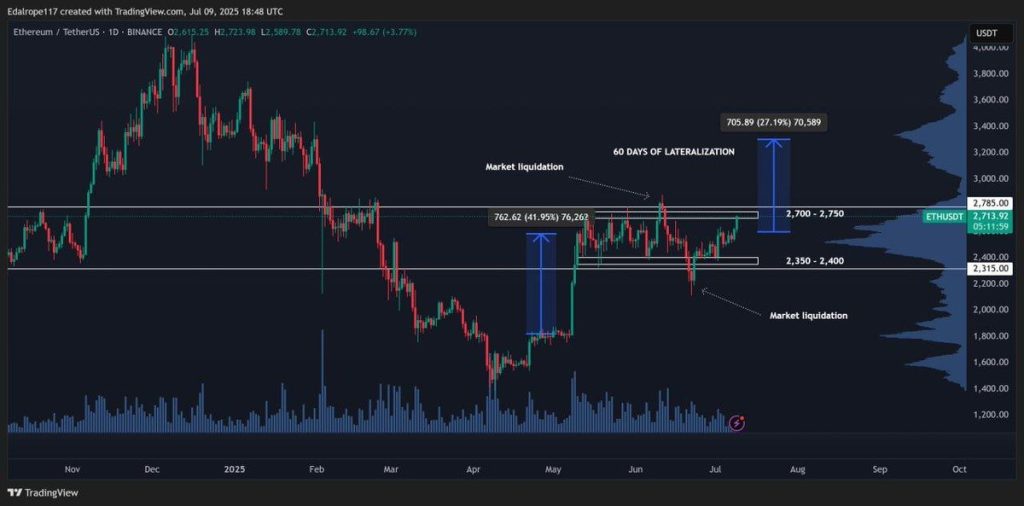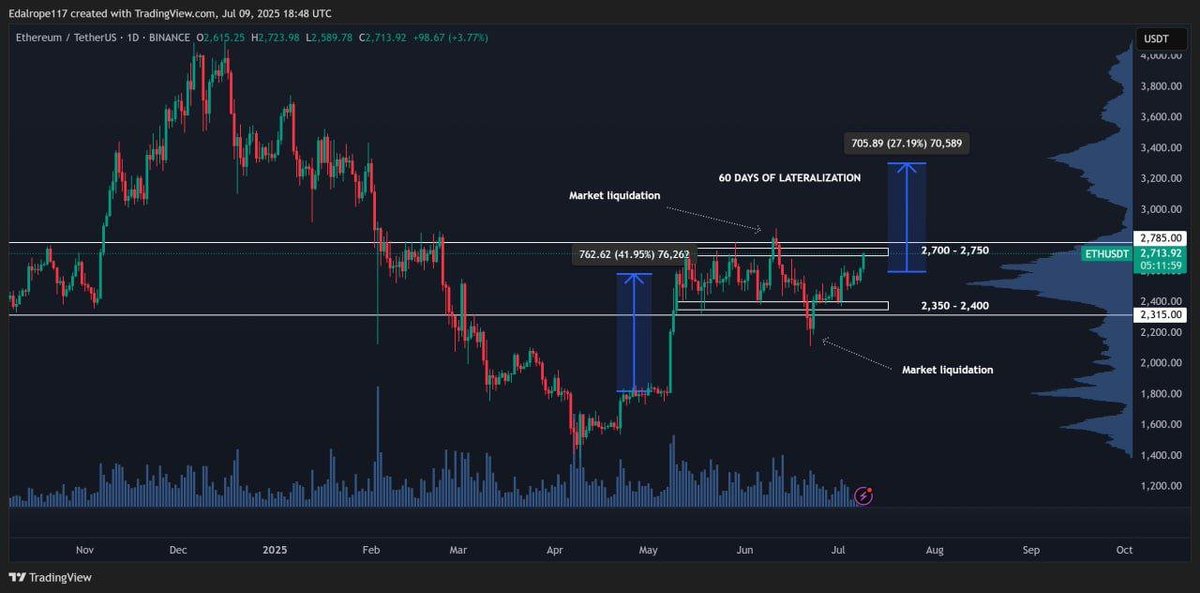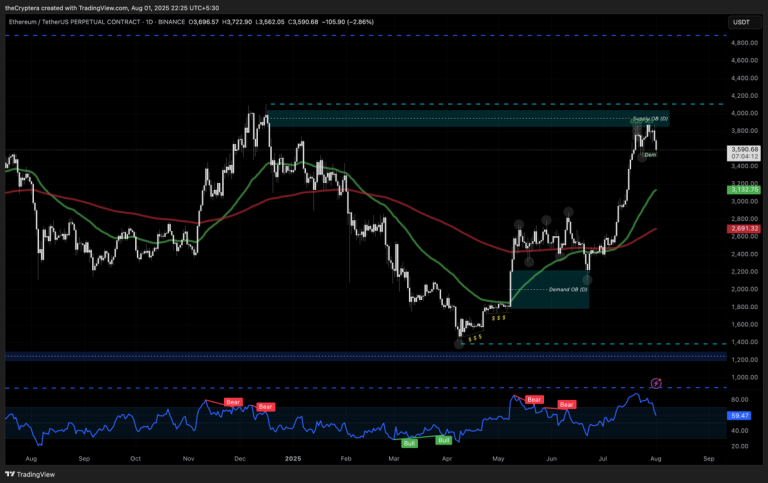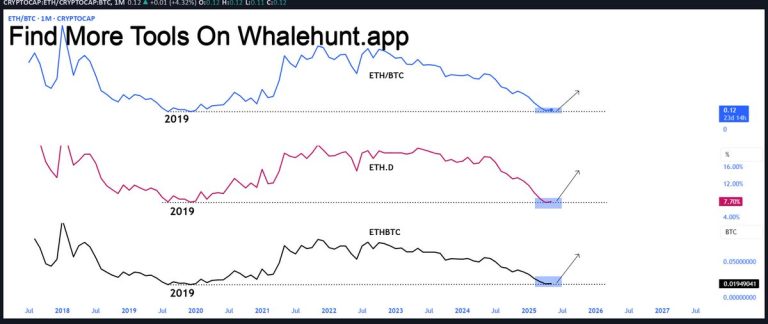
The Ethereum Sideways Shuffle: A Deep Dive into Current Market Dynamics
The cryptocurrency landscape is rarely static, yet sometimes it feels…paused. Right now, that’s precisely the sensation surrounding Ethereum (ETH). As Loki Trades pointed out today, July 9th, 2025, ETH has been remarkably range-bound for sixty days, a period of consolidation following a significant 40%+ surge in just three days [1]. This isn’t necessarily a bad thing; it’s a breathing space, a period of accumulation, and a time for underlying technological developments to mature. But what’s *really* happening? And how can we interpret this sideways movement in the context of Bitcoin’s own relatively stable period? This analysis will explore the current state of ETH, the technological advancements brewing beneath the surface, and the implications for potential future movements.
The Significance of Sideways Trading
Sixty days of sideways trading is a considerable length of time in the volatile world of crypto. It suggests a balance between buying and selling pressure, a tug-of-war where neither side can decisively gain control. This often happens after a substantial price increase, like the one ETH experienced earlier. The initial surge attracts attention and investment, but it also leads to profit-taking, creating a temporary equilibrium.
However, sideways movement isn’t simply “doing nothing.” It’s a period of market digestion. It allows traders to reassess, new investors to enter, and the overall market structure to solidify. Crucially, it also allows for the development and anticipation of future catalysts. In ETH’s case, those catalysts are increasingly tied to technological advancements, specifically Layer-2 scaling solutions and the emergence of new, high-performance blockchains like Monad.
Layer-2 Solutions and the Quest for Scalability
Ethereum’s biggest challenge has always been scalability. The network can only process a limited number of transactions per second, leading to high gas fees and network congestion, especially during periods of high demand. Layer-2 solutions are designed to address this by processing transactions *off-chain* and then settling them on the main Ethereum blockchain. This dramatically increases throughput and reduces costs.
While many Layer-2 solutions exist (Optimism, Arbitrum, zkSync, etc.), their continued development and adoption are crucial for ETH’s long-term success. The sideways trading period allows these solutions to mature, attract users, and demonstrate their capabilities without the pressure of a rapidly changing price environment. Increased activity on Layer-2s effectively expands the Ethereum ecosystem without directly impacting the main chain’s congestion.
Monad: A New Contender in the High-Performance Blockchain Space
Beyond Layer-2s, a new generation of blockchains is emerging, aiming to surpass Ethereum in terms of speed and efficiency. Monad is one such project, and its technological approach is particularly noteworthy. As Alican Çebi highlights, Monad utilizes “Optimistic Parallel Execution” [3]. This is a significant departure from Ethereum’s current execution model.
Ethereum currently processes transactions sequentially, one after another. This is a safe but slow approach. Optimistic Parallel Execution, however, allows Monad to analyze dependencies between transactions and execute those that *don’t* conflict simultaneously. This dramatically increases transaction throughput. Think of it like a highway: Ethereum is a single-lane road, while Monad is a multi-lane highway where cars (transactions) can travel side-by-side if they aren’t heading to the same destination.
The implications of this are substantial. Faster transaction speeds and lower fees could attract developers and users away from Ethereum, potentially challenging its dominance. However, it’s important to remember that Monad is still under development and faces its own set of challenges, including security and network effects.
The Role of Blockchain Forensics and Regulatory Scrutiny
While technological innovation drives growth, the increasing scrutiny from regulators and law enforcement cannot be ignored. The rise of cryptocurrency has also brought with it concerns about illicit activity, such as money laundering and terrorist financing. This is where blockchain forensics tools come into play.
As Gozman Gonzalez points out, tools like Chainalysis, TRM Labs, Elliptic, and CipherTrace are essential for investigators analyzing blockchain activity [2]. These “RegTech” tools scan blockchains like Bitcoin, Ethereum, and BNB Chain, mapping out wallet activity and identifying potentially suspicious transactions.
This increased scrutiny isn’t necessarily negative for Ethereum. While it may deter some illicit actors, it also lends legitimacy to the ecosystem. A more transparent and regulated environment can attract institutional investors and foster wider adoption. The ability to trace transactions and identify bad actors is crucial for building trust and ensuring the long-term sustainability of the cryptocurrency market.
Bitcoin’s Influence and the Interconnected Market
The analysis of ETH cannot be divorced from the performance of Bitcoin (BTC). As the original cryptocurrency, Bitcoin often sets the tone for the entire market. The current period of relative stability in BTC is providing a supportive backdrop for ETH’s consolidation.
When Bitcoin is volatile, investors often flock to it as a “safe haven,” pulling capital away from altcoins like ETH. However, when Bitcoin stabilizes, investors are more willing to explore other opportunities, including ETH and its burgeoning ecosystem. The fact that BTC has remained within a defined range allows ETH to focus on its own internal developments and build momentum without being constantly buffeted by Bitcoin’s price swings.
Looking Ahead: Potential Breakout Scenarios
So, what’s next for Ethereum? The prolonged sideways trading suggests that a breakout is inevitable, but the direction of that breakout remains uncertain. Several scenarios are possible:
- Bullish Breakout: If Layer-2 solutions continue to gain traction, Monad demonstrates its potential, and regulatory clarity improves, ETH could break out to the upside, potentially surpassing its previous all-time high. This scenario would likely be fueled by renewed investor enthusiasm and increased adoption.
- Bearish Breakdown: If Layer-2 adoption stalls, Monad fails to deliver on its promises, or regulatory headwinds intensify, ETH could break down to the downside, potentially testing lower support levels. This scenario would likely be driven by fear, uncertainty, and doubt (FUD).
- Continued Consolidation: It’s also possible that ETH could continue to trade sideways for an extended period, particularly if there are no major catalysts to drive a decisive move in either direction. This scenario would represent a period of stagnation, but it wouldn’t necessarily be negative, as it would allow for further development and maturation of the ecosystem.
Ultimately, the future of Ethereum will depend on a complex interplay of technological innovation, regulatory developments, and market sentiment. The current sideways trading period is a critical juncture, a time for ETH to solidify its foundations and prepare for the next phase of its evolution.
A Moment of Potential
The current state of Ethereum isn’t a period of inactivity, but rather a crucial phase of preparation. The sideways movement isn’t a sign of weakness, but a necessary pause before the next leap forward. The advancements in Layer-2 scaling and the emergence of innovative blockchains like Monad represent genuine progress. Coupled with the increasing sophistication of blockchain forensics, Ethereum is positioning itself for a future where scalability, security, and regulatory compliance are paramount. The next few weeks and months will be critical in determining which path ETH will take, but one thing is certain: the future of Ethereum, and indeed the broader cryptocurrency landscape, remains full of potential.
Sources:
[1] https://twitter.com/iamLokiTrades/status/1677744999999999999
[2] https://twitter.com/GozmanGonzalez/status/1677745444444444444
[3] https://twitter.com/alican_cebi/status/1677745777777777777








